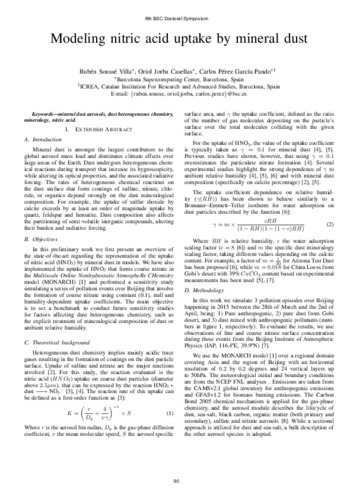Modeling nitric acid uptake by mineral dust

Visualitza/Obre
Estadístiques de LA Referencia / Recolecta
Inclou dades d'ús des de 2022
Cita com:
hdl:2117/346629
Tipus de documentText en actes de congrés
Data publicació2021-05
EditorBarcelona Supercomputing Center
Condicions d'accésAccés obert
Tots els drets reservats. Aquesta obra està protegida pels drets de propietat intel·lectual i
industrial corresponents. Sense perjudici de les exempcions legals existents, queda prohibida la seva
reproducció, distribució, comunicació pública o transformació sense l'autorització del titular dels drets
Abstract
Mineral dust is amongst the largest contributors to the
global aerosol mass load and dominates climate effects over
large areas of the Earth. Dust undergoes heterogeneous chemical
reactions during transport that increase its hygroscopicity,
while altering its optical properties, and the associated radiative
forcing. The rates of heterogeneous chemical reactions on
the dust surface that form coatings of sulfate, nitrate, chloride,
or organics depend strongly on the dust mineralogical
composition. For example, the uptake of sulfur dioxide by
calcite exceeds by at least an order of magnitude uptake by
quartz, feldspar and hematite. Dust composition also affects
the partitioning of semi-volatile inorganic compounds, altering
their burden and radiative forcing.
CitacióSoussé Villa, R.; Jorba Casellas, O.; Pérez García-Pando, C. Modeling nitric acid uptake by mineral dust. A: . Barcelona Supercomputing Center, 2021, p. 90-92.
| Fitxers | Descripció | Mida | Format | Visualitza |
|---|---|---|---|---|
| BSC_DS-2021-33_Modeling nitric acid uptake.pdf | 1,850Mb | Visualitza/Obre |

